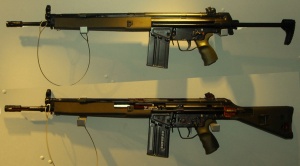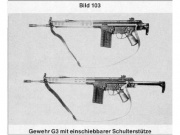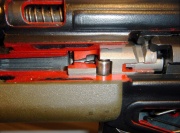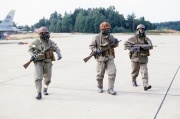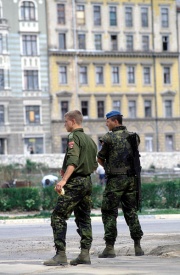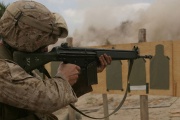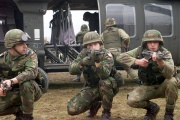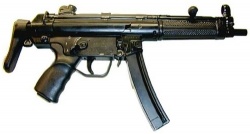Heckler & Koch G3
| |||||||||||||||||||||||||||||||||||||||||||||||||||||||||||
The G3 is a 7.62 mm automatic rifle developed in the 1950s by the German armament manufacturer Heckler & Koch GmbH (HK) in collaboration with the Spanish state-owned design and development agency CETME (Centro de Estudios Técnicos de Materiales Especiales).[1]
Contents[hide] |
[edit] Development
The origin of this rifle can be traced back to the end of World War II when engineers at the German Mauser factory designed the 7.92 mm StG45 assault rifle,[1] first with the Gerät 06 ("device 06") using a roller-delayed blowback mechanism originally adapted from the roller-locked recoil operating system of the MG42 machine gun but with a fixed barrel and gas system. It was realized that with careful attention to the mechanical ratios, the gas system could be omitted. The resultant weapon, the Gerät 06(H) was assigned the designation StG45(M) but was not produced beyond prototype stage.
This mechanism would later be developed by former Mauser engineers Vorgrimmler, Löffler and Kunert at AME (Atelier Mécanique de Mulhouse) in Alsace between 1946 and 1949. Three versions were made chambered in .30 Carbine, 7.92x33mm Kurz as well as the 7.65x35mm cartridge developed by Cartoucherie de Valence and adopted in 1948; a 7.5x38mm variant was abandoned. The AME 49 under the name Carabine Mitrailleuse 1950 (English: "machine carbine", German: Maschinenkarabiner) was retained for production among 12 different prototypes designed by AME , MAC and MAS.
Engaged in the Indochina War and being the second NATO contributor, France canceled the adoption of these new weapons for financial reasons. The German technicians moved to Spain and created the LV-50 rifle chambered in the intermediate 7.92x33mm Kurz cartridge and later, the proprietary 7.92x40mm CETME M53 round.[1] At this point, the rifle was renamed the Modelo 2. The Modelo 2 attracted a lot of attention from the West German Border Guards (Bundesgrenzschutz), which sought a new service rifle. Not willing to accept a cartridge outside of the NATO specification, the Germans asked CETME to develop a 7.62 mm version of the rifle. The resulting CETME Model A was chambered for the 7.62x51mm CETME cartridge which has identical chamber dimensions but a reduced-power load compared to the 7.62x51mm NATO round. Further development of the rifle with input from HK produced the CETME Model B which received several modifications including the ability to fire from a closed bolt in both semi-automatic and automatic firing modes, a new perforated sheet-metal handguard (the folding bipod had been the foregrip in previous models), improved ergonomics and a slightly longer barrel with a rifle grenade launcher guide. In 1958, this rifle was introduced into service with the Spanish Army as the Modelo 58, firing the 7.62x51mm CETME round.
In 1956, the Bundesgrenzschutz canceled its planned procurement of the CETME rifles, adopting the FN FAL (G1) instead. However, the newly formed West German Army (Bundeswehr) now displayed interest and soon purchased a number of CETME rifles (7.62x51mm NATO chambering) for further testing. The CETME, known as the Automatisches Gewehr G3, competed successfully against the SIG SG 510 (G2) and AR-10 (G4) to replace the previously favored G1 rifle. In January 1959, the Bundeswehr officially accepted the CETME rifle. The West German government wanted the G3 rifle to be produced under license in Germany; purchase of the G1 had previously fallen through over FN's refusal to grant such a license. In the case of the G3, the Dutch firm Nederlandse Wapen en Munitiefabrik (NWM) held production and sales rights to the CETME design outside of Spain. To acquire production rights, the West German government offered NWM contracts to supply the Luftwaffe with 20 mm ammunition. Production of the G3 was then assigned to Rheinmetall and HK. The latter company already had ties to CETME, and had worked to further optimize the CETME rifle for use with the full-power 7.62x51mm NATO cartridge (as opposed to the downloaded CETME variant). In 1969, Rheinmetall gave up production rights to the G3 in exchange for HK's promise not to bid on MG3 production. Later in 1977, the West German government ceded ownership of G3 production and sales rights exclusively to HK.
Initial production G3 rifles differed substantially from more recent models; early rifles featured closed-type mechanical flip iron sights (with two settings), a lightweight folding bipod, stamped steel handguard, wooden buttstock (in fixed stock models) and a telescopic metal stock (in folding stock models).[1] The weapon was modernized during its service life (among other minor modifications it received new sights, a different flash hider, a plastic foregrip and stock), resulting in the current production variants, the G3A3 (with a fixed synthetic stock) and the G3A4 (telescoping metal stock). The rifle proved successful in the export market, being adopted by the armed forces of over 40 countries.[1] The G3 was and in some cases continues to be produced under license in: France ( MAS), Greece (Hellenic Arms Industry), Iran (Defense Industries Organization), Mexico, Myanmar, Norway (Kongsberg Våpenfabrikk), Pakistan (Pakistan Ordnance Factories), Portugal (FBP), Saudi Arabia, Sweden (FFV), Thailand, Turkey (MKEK) and the United Kingdom (Royal Ordnance).[1]
[edit] Design details
The G3A3 (A4) is a selective-fire automatic weapon that employs a roller-delayed blowback operating system. The two-piece bolt assembly consists of a breech (bolt head) and bolt carrier. The bolt is partially locked in battery by two sliding cylindrical rollers that engage locking recesses in the barrel extension. The breech is unlocked when both rollers are compressed inward against camming surfaces driven by the rearward pressure of the expanding exhaust gases upon the bolt head. As the rollers move inward recoil energy is transferred to the locking piece and bolt carrier which begin to withdraw while the bolt head remains locked. As the bolt carrier clears the rollers, pressure in the bore drops to a safe level, the bolt head is unlocked and begins to recoil backwards at a velocity lower than that of the bolt carrier. The bolt also features an anti-bounce mechanism that prevents the bolt from bouncing off the barrel's breech surface. The spring-powered claw extractor is also contained inside the bolt while the lever ejector is located inside the trigger housing (actuated by the recoiling bolt).[1]
The rifle is hammer fired and has a trigger mechanism with a 3-position fire selector switch that is also the manual safety toggle that secures the weapon from accidentally discharging (fire selector in the “E” or “1” position – single fire mode, “F” or “20” – automatic fire, “S” or “0” – weapon is safe, trigger disabled mechanically). The weapon can be fitted with an optional 4-position safety/fire selector group illustrated with pictograms with an ambidextrous selector lever. The additional, fourth selector setting enables a 3-round burst mode of fire.[1]
The G3A3 (A4) uses either steel (260 g) or aluminum (140 g) double-stacked straight box magazines.
The firearm was equipped with iron sights that consist of a rotary rear drum and hooded front post. The rear sight, mechanically adjustable for both windage and elevation, has an open notch used to fire up to 100 m and three apertures used for: 200, 300 and 400 m.[1] The receiver housing has recesses that work with HK clamp adapters used to mount day or night optics.
The rifled barrel (contains 4 right-hand grooves with a 305 mm twist rate) is ended with a slotted flash suppressor which can also be used to attach a bayonet or serve as an adapter for launching rifle grenades. The barrel chamber is fluted, which assists in the initial extraction of a spent cartridge casing (since the breech is opened under very high barrel pressure).[1]
Standard accessories supplied with the rifle include: a detachable bipod (not included with rifles that have a perforated plastic handguard), sling, cleaning kit and a speed-loading device. Several types of bayonet are available for the G3, but with few exceptions they require an adapter to be inserted into the end of the cocking tube. The most common type features a 6 3/4 inch spear-point blade nearly identical with the M7 bayonet, but with a different grip because of its mounting above the barrel. A variant of this exists with an 9 1/4-inch blade that is completely double-edged like a dagger. A rather shoddily made Pakistani bayonet with a British-style bowie blade also exists, and one of the Eickhorn KCB77 variants fits the G3. The weapon can also mount a 40 mm HK79 under-barrel grenade launcher, blank firing adapter a straight blowback bolt (called a “PT” bolt, lacks the locking rollers) used for firing 7.62x51mm ammunition with plastic bullets, a conversion kit used for training with .22 LR ammunition and a sound suppressor (that uses standard ammunition).
Apart from the G3A3 and G3A4 HK also built: the G3A3ZF (essentially a G3A3 with a Hensoldt 4x24 optical sight), the accurized G3SG/1 rifle (hand-selected G3A3’s, equipped with an improved trigger, Zeiss telescopic sight with a variable 1.5-6x magnification and a cheek riser) and the G3K carbine which uses an HK33 handguard and a short barrel (reduced in length to the base of the front sight post), that is too short for use with a bayonet or rifle grenades.[1]
The G3 served as a basis for many other weapons, among them: the PSG1 and MSG90 precision rifles, the HK11 and HK21 family of light machine guns, a single-fire version known as the HK91, a sporterized model called the SR9 (designed for the civilian market) and the MC51 carbine, produced by the UK firm FR Ordnance International Ltd. for special forces. The MC51 weighs 3.1 kg (6.8 lb), has a folded overall length of 625 mm (24.6 in), a barrel length of only 230 mm (9.1 in), which produces a muzzle velocity of approx. 690 m/s (2,263.8 ft/s) and a muzzle energy of 2215 J. The MC51 was allegedly manufactured for the British SAS and SBS, who required a compact but powerful weapon, for situations in which the stopping power and armor piercing capabilities of 9x19mm Parabellum round were inadequate. Only 50 weapons were produced, and all were reportedly shipped to the UK special forces. Most of them were soon replaced by the Heckler & Koch HK53 carbine. Another UK-based company called Imperial Defence Services Ltd. absorbed FR Ordnance and continues to market the MC51 standard variant. In addition, a weapon similar to the MC51 called the M41 Offizier is produced by Schwaben Arms GmbH of Germany.[2]
[edit] Variants
- G3: Original model based on the CETME Modelo B.
- G3A1: G3 with a single position, collapsible stock. This design was chosen after earlier experimentation with a ventrally-folding stock. Excessive recoil caused the latter to be dropped from consideration.
- G3A2: G3 with new rotating drum rear sight.
- G3A3: The most well known version. Drum sights, a fixed plastic buttstock, and a plastic handguard that does not contact the barrel. The handguard came in a slim, ventilated version and a wide version. The latter allows for the attachment of a bipod.
- G3A3A1: This is a version of the G3A3 with an ambidextrous trigger group and brass deflector. This is an official German Army designation, not a HK factory one.
- G3A4: The G3A4 uses drum sights and a single position, collapsible stock. This rifle could also be issued with a scope with the nomenclature G3A4ZF. The ZF stands for Zielfernrohr or "Telescope".
- G3A4A1: This is a variant of the G3A4 with an ambidextrous trigger group and brass deflector. This is an official German Army designation, not a HK factory one.
- G3KA4: Smallest of the line, it is a Karabiner, or carbine version of the G3. It features drum sights, a retractable stock, and a and a 315 mm (12.4 in) barrel.
- G3KA4A1: Variant of the G3KA4 with an ambidextrous trigger group and brass deflector. This is an official German Army designation, not a HK factory one.
- G3A5: HK assigned model number for the HK-made Danish version of the G3A3. It differs in that it has a silent bolt-closure device. In Danish service it is known as the Gv M/66. The Gv M/66 was originally intended for use with optics as a designated marksman rifle, while the rest of the squad were issued M1 Garands.
- G3A6: HK assigned model number for the Iranian-made version of the G3A3.
- G3A7: HK assigned model number for the Turkish-made version of the G3A3.
[edit] Other military variants and derivatives
- Gv M/75: Variant leased from the German Bundeswehr / German government by the Danish government to replace the aging M1 Garands. Originally manufactured by either Rheinmetall or HK for the German Bundeswehr. The Gv M/75 rifles are basically G3's with the old style straight cocking tube as opposed to the later FS (Freischwinger) variant. Semi-automatic normally, though could be converted to fully automatic fire by changing the safety lever. This is done without tools.
- AG-3: Norwegian variant of the G3A5. Produced by Kongsberg Våpenfabrikk. A total of 253,497 units were produced for the Norwegian Armed Forces from 1967 to 1974. The Norwegian AG-3 differs from the original G3; it has a buttstock that is approx. 2 cm longer, the bolt carrier has a serrated thumb groove to aid in silent bolt closure, it features an all-metal cocking handle and a different bayonet mount. On April 11, 2007, it was announced that the AG-3 would be replaced by the Heckler & Koch HK416, in all military branches except for certain groups of the Heimevernet (Home Guard).
- AG-3F1: An AG-3 with a retractable stock as on G3A4. Produced by Kongsberg Våpenfabrikk. A retractable stock was required by certain groups of soldiers within the Norwegian Armed Forces, primarily vehicle crews with limited space inside, particularly where a quick disembarkment from such a vehicle is required. All versions of the AG-3 have the ability to attach a 40 mm HK79 grenade launcher.
- AG-3F2: An improvement of the AG-3F1, featuring Picatinny rails on the receiver as well as the foregrip.
- Ak 4: Swedish-made version of the G3A3. The rifles were manufactured from 1965 to 1970 by both Carl Gustafs Stads Gevärsfaktori and Husqvarna Vapenfabrik and from 1970 until the end of production in 1985 - exclusively by Gevärsfaktori in Eskilstuna. Also produced with a Hensoldt 4x24 telescopic sight mounted via a HK claw mount, known as the Ak 4OR and the Ak 4B variant, which features an Aimpoint red-dot reflex sight in place of the standard iron sights and an increased rate of fire. All Ak 4s are adapted to mount the M203 grenade launcher.
- DIO G3 Bullpup: Iranian bullpup variant of the G3. Photo
- G3A7A1: Turkish-made variant of the G3A4.
- G3P4: Pakistan Ordnance Factory designation for license produced G3A4 rifles.
[edit] Specialized G3 types
- G3TGS: This is simply a G3 with a 40 mm HK79 under-barrel grenade launcher. TGS stands for Tragbares Granat System ("portable grenade system").
- G3A3ZF: This is a rifle issued with a scope bracket and a scope. The ZF stands for Zielfernrohr or "telescopic sight".
- G3SG/1: An accurized variant of the G3. The "SG" stands for Scharfschützengewehr, or "sharpshooting rifle". The rifles were individually selected from the production line for their accuracy and then modified. A Zeiss 1.5-6x variable power telescopic sight was added using a HK claw mount attached to the receiver. The stock was extended slightly compared to the standard G3 fixed stock and comes with a heavy, dual-stage buffer and adjustable cheek rest. A special set trigger group was added for a crisp trigger pull of 1 lb. Automatic fire was retained.
- MSG3: a variant featuring the newer scope mount that is found on only a few of the Heckler & Koch rifles, as compared to the more conventional claw mounts, though the claw mounting points remain on the receiver. This newer scope mount does not allow the use of the open sights with the mount in place, as is the case with the more conventional claw mount.
[edit] Law enforcement and civilian models
- HK41: The HK41 is a semi-automatic version of the G3 that was marketed to law-enforcement and civilian reservists (the prefix number 4 in HK's two-digit number system technically stands for "para-military rifle"). There were two versions, one differing from the G3 by being fitted with a semiautomatic-only trigger pack, the other using a different design of trigger pack, like that of the later HK91. The first version could easily be converted to a full-automatic weapon by swapping out several parts. Limited sales at home and US import restrictions and firearms regulations led this weapon to be dropped from HK's product line quickly and it was replaced by the HK91.
- HK91: The HK91 is a semi-automatic version of the G3 similar to the HK41, also marketed to civilians. However, in order to comply with US firearm regulations a number of modifications to the HK91 were made that do not appear on the first pattern HK41. Internal parts that could allow fully automatic fire were removed. A shelf was welded onto the receiver where the push-pin of the trigger pack would normally go, to prevent installation of a fully automatic trigger pack. This did not allow the use of the paddle style magazine release and so the magazine release button on the right side of the magazine well must be used instead. This was considered awkward by many owners. It is otherwise identical to the G3A3/A4. Importation into the United States began in 1974 and ceased in 1989, with some 48,000 rifles being imported.
- HK911: The HK911 was an HK91A2 with the flash hider removed and the receiver re-stamped with an extra 1 to comply with the US importation ban of 1989. The new designation theoretically made it legally immune to the Import Ban, as no "HK911" rifles were mentioned on the list of banned guns. However, the later banning of several "paramilitary" features on the HK911 made it illegal.
- SR9: These variants of the HK91ZF were created to get around the Semi-Auto Import Ban of 1989, which included all variants of the HK91. They differed from the HK91 in that they had their flash hiders removed and featured a smooth forend that lacked the bipod attachment point. The SR9 series were banned from importation to the United States by President Clinton in 1997 because they could accept high-capacity magazines. The SR9 was an HK91A2ZF with the pistol grip and buttstock replaced with a one-piece thumbhole stock.
- SR9 (T): The (T), or "Target", model was an HK91A2ZF with the trigger replaced with the PSG-1 model, the pistol grip replaced with an ergonomic PSG-1 grip and the buttstock replaced with an MSG90 model.
- SR9 (TC): The (TC), ot "Target Competition", model was an HK91A2ZF with the trigger group, pistol grip and buttstock derived from the PSG-1.
- G3A1: The terminology used by custom gunsmiths (e.g. Choate) and importers (e.g. Interarms) for weapons with an aftermarket side-folding stock. This is not part of official HK nomenclature.
- HK 51: The HK51 is not made by HK, instead being a creation of the American custom after-market. The HK 51 has no real standards but is usually a cut down and modified G3A3 or its semi-automatic clones the HK41 and HK91 and modified to take MP5 furniture and accessories. It is usually fitted with a collapsible stock; 211 mm (8.31 in) barrel; it is 589 mm (23.17 in) in length with the stock retracted and 780 mm (30.72 in) with the stock extended.
- PTR 91F: Additionally, JLD started manufacturing semi-automatic copies of the HK G3 called the PTR 91 in the United States. They used tooling from the FMP arms factory in Portugal to build the rifles.
[edit] Users
[edit] NATO
- Denmark: G3A5, as the Gevær Model 1966 (Gv M/66). Another variant, designated Gevær Model 1975 (Gv M/75) was leased from the German government. Almost all G3s in Danish service were replaced in the late 1990s by the Diemaco C7 rifle, designated Gv M/95, and the Diemaco C8 carbine, designated Gv M/96. Conscripts are sometimes still taught to operate the rifle, due to shortages of M/95 if the Total Defence force is to be activated. The Danish Home guard issued the Gv M/66 as late as 2006.
- Estonia: Uses Swedish-made Ak 4s.[3]
- France: Formerly made by MAS under contract from Heckler & Koch. Manufactured primarily for export to nations such as Lebanon. No longer produced.
- Germany: Mostly replaced by the Heckler & Koch G36, but still large quantities in storage and sometimes used as DMRs.
- Greece: Made under license by Ellinika Amyntika Systimata (EAS) (English - "Hellenic Defense Systems"),[4] formerly under Elliniki Biomihania Oplon (EBO) ("Hellenic Arms Industry"). It replaced the American M1 Garand in the late 1970s. It is still the main service rifle of the Hellenic Army.
- Iceland: Used by the Coast Guard (replacing the Lee-Enfield bolt-action rifle) and the Icelandic Crisis Response unit (both the G3A5 and AG-3 variants).
- Italy
- Latvia: Mostly uses Swedish-made Ak 4s and some G3A3 models.
- Lithuania: Uses Swedish-made Ak 4s.
- Norway: AG-3, a modified G3A5 made by Norsk Forsvarsteknologi, later renamed to Kongsberg Våpenfabrikk. To be replaced by the Heckler & Koch HK416.
- Netherlands
- Portugal: Made under license by INDEP as the m/961 (G3) and m/963 (G3A3).
- Turkey: Made under license by Makina ve Kimya Endüstrisi Kurumu (MKEK) ("Mechanical and Chemical Industry Corporation") as the G3A7.[5]
- United Kingdom - The G3KA4 is designated L100A1 by the British. These were most likely fabricated from receivers produced locally under license, along with G3A3/4s at the Royal Small Arms Factory, Enfield. They have now been phased out. However, they are still in use with CO19, the police armed response unit.
[edit] Non-NATO
- Albania: Used by the Albanian Special Police force RENEA and Albanian peacekeeping forces in Afghanistan.
- Angola
- Argentina: Used by special operations groups such as the Hawk Special Operations Brigade.
- Azerbaijan
- Bahrain
- Bangladesh: Manufactured by the Bangladesh Ordnance Factory.
- Bolivia
- Bosnia and Herzegovina
- Brazil: Used by BOPE.
- Burkina Faso
- Burundi
- Cambodia: Used by the Khmer Republic during the Cambodian Civil War and also by the Royal Cambodian Army.
- Chad
- Chile: In use in limited numbers by the artillery troops, reserves and training units.
- Colombia: Replaced by the Galil in 1993, both from IMI and Indumil.
- Côte d'Ivoire
- Croatia
- Cyprus
- Djibouti
- Dominican Republic
- Ecuador
- El Salvador
- Ethiopia
- Gabon
- Guyana
- Haiti
- Iran: Manufactured locally by Defense Industries Organization.
- Indonesia: Employed by the Indonesian Air Force, special forces (the Korphaskhas) since the early 1960s during the campaign against the Dutch in West Irian. The gun is currently held in reserve and training formations.
- Jordan
- Kenya
- Kuwait
- Lebanon: Used in very limited numbers with the ISF (Internal Security Forces), and in the Lebanese Army.
- Libya
- Malawi
- Malaysia: Both Malaysian Grup Gerak Khas, Paskal, VAT 69 and UTK special forces used the G3SG/1 as their primary sniping rifle since the early 1970s. In 1990 the G3 was replaced by the MSG-90 and PSG-1 as their primary precision rifles.
- Mauritania
- Mexico: Made under license by DIM (Departamento de la Industriá Militar) and DGFD (Dirección General de Fábricas de la Defensa), being phased out and replaced by the FX-05 assault rifle.
- Morocco
- Myanmar: Known as the Ka Pa Sa BA-63 (G3A3), BA-72 (G3K) and BA-100 (G3A3ZF) built at the Ka Pa Sa state factories.
- Niger
- Nigeria: Under license by Defense Industries Corporation[6].
- Pakistan: Variants in use by the Pakistani military are locally produced by Pakistan Ordnance Factories in Wah Cantt. Manufactured are the G3A3 and a version of the G3A4, which carries the factory designation G3P4.[7]
- Paraguay: The gun is currently held in reserve and training, while slowly being replaced by the M16 rifle.
- Peru
- Philippines
- Qatar
- Rhodesia: Used by the Rhodesian army in select units, most notably by the Grey's Scouts during the Bush War.
- Saudi Arabia: Made under license by Al Kharj Arsenal.
- Senegal
- Sierra Leone
- Somalia
- South Africa: The rifle saw limited use in the South African Border War.
- Sri Lanka: Purchased a few thousand Pakistani-made G3A3s to fight against Tamil militants in the early 1980s and currently those rifles are being replaced by the Chinese Type 56.
- Sudan: Made under license by Military Industry Corporation as the Dinar.[8]
- Sweden: Made under license by Förenade Fabriksverken (FFV) as the Ak 4 (Automatkarbin 4).[9] Two sub-variants are known to exist, one equipped with a rail and Aimpoint sight (Ak 4B) and the other with a 4x magnifying optic (Ak 4OR). It has since been replaced by the Ak 5 (Automatkarbin 5; a modified version of the FN FNC) in the regular army. It is still in use in Hemvärnet ("Swedish Home Guard").
- Tanzania
- Thailand
- Togo
- Uganda
- United Arab Emirates
- Yemen
- Zaire
- Zambia: Issued to Zambian paramilitary forces.
- Zimbabwe
[edit] Resources
The Gun Owners' Resource online library has the following manuals available for free download for this firearm:
- Armorer's Manual: Instructions for Maintenance and Repair - HK International Training Division (1.36MB .PDF file, 50 pgs)
- HK G3 User's Manual - Survival Books (2.7MB .PDF file, 57 pgs)
- SAR-8 Sporter Care, Maintenance and Operating Instructions - for Springfield Armory variant (1.4 MB .PDF file, 12 pgs)
The following images are also available for reference:
[edit] See also
[edit] Notes
- ↑ 1.00 1.01 1.02 1.03 1.04 1.05 1.06 1.07 1.08 1.09 1.10 Woźniak, Ryszard. Encyklopedia najnowszej broni palnej - tom 2 G-Ł. Bellona. 2001. pp7-10.
- ↑ Page 12
- ↑ Eesti Kaitsevägi - Tehnika - Automaat AK-4
- ↑ Hellenic Defense Systems
- ↑ G3 – A4 AUTOMATIC INFANTRY RIFLE.
- ↑ Nigeria: Arms Procurement and Defense Industries. Retrieved on October 5, 2008.
- ↑ http://www.pof.gov.pk/products/autorifles.htm
- ↑ Military Industry Corporation (MIC) Official Website
- ↑ http://www.mil.se/sv/Materiel-och-teknik/Vapen/Automatkarbin-4/
[edit] References
- Les fusils d'assaut français "The french assault rifles" by Jean Huon, published by Editions Barnett in 1998, ISBN 2-9508308-6-2.
- Gotz, Hans Dieter, German Military Rifles and Machine Pistols, 1871-1945, Schiffer Publishing, Ltd. West Chester, Pennsylvania, 1990. OCLC 24416255
- Senich, P. (1987). German Assault Rifle: 1935-1945. Paladin Press. ISBN 0-87364-400-X.
- G. de Vries, B.J. Martens: The MP 43, MP 44, StG 44 assault rifles, Propaganda Photos Series, The Sturmgewehr, Volume 4, Special Interest Publicaties BV, Arnhem, The Netherlands. First Edition 2001.
- Smith, W.H.B, Small arms of the world : the basic manual of military small arms, Harrisburg, Pa. : Stackpole Books, 1955. OCLC 3773343
- Afonso, Aniceto and Gomes, Carlos de Matos, Guerra Colonial, 2000.
- Günter Wollert; Reiner Lidschun; Wilfried Kopenhagen, Illustrierte Enzyklopädie der Schützenwaffen aus aller Welt : Schützenwaffen heute (1945-1985), Berlin : Militärverlag der Deutschen Demokratischen Republik, 1988. OCLC 19630248
- Clinton Ezell, Edward; Small arms of the world, Eleventh Edition, Arms & Armour Press, London, 1977
- (Polish) Wozniak, Ryszard (2001). "p. 7-10", Encyklopedia najnowszej broni palnej - tom 2 G-Ł. Warsaw, Poland: Bellona. ISBN 83-11-09310-5.
[edit] External links
- Buddy Hinton collection / HK
- HK museum
- G3 rifle variations
- Modern Firearms
- Heckler and Koch G3 disassembled (In German)
- 7.62 NATO Battle Rifles
| [show]This article is part of a series on Heckler & Koch firearms |
|---|
